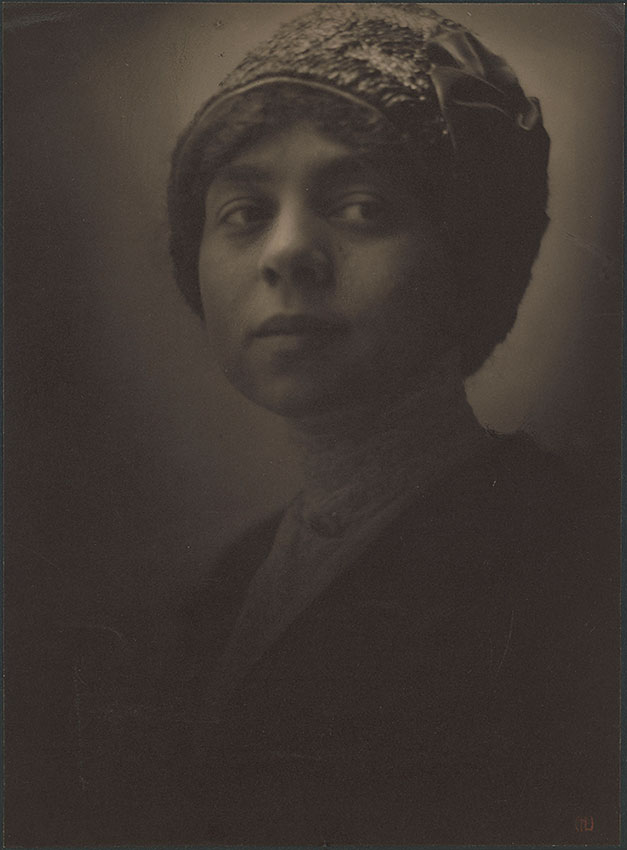Clarence H. White

Arguably the most famous photographs of Belle da Costa Greene were taken by the photographer Clarence H. White in 1911. There are nine known images of Greene by White, with prints preserved at the Morgan, I Tatti, and Princeton University Art Museum. Those at I Tatti were given to Bernard Berenson by Greene, who appears to make several references to them in her letters to Bernard. White was part of the circle surrounding Alfred Stieglitz (1864–1946) and the Little Galleries of the Photo-Secession, later known as 291 (named for its Fifth Avenue address). Greene knew and corresponded with Stieglitz, attended exhibitions at 291 (acquiring a Matisse drawing and Steichen photographic print there), and was caricatured by the Mexican-American artist Marius de Zayas, who also caricatured Clarence White. According to art historian Anne McCauley, Belle Greene wore in these photographs "a new type of close-fitting hat that conveniently hid her revealingly African American hair" (116). The few quotes in her letters to Berenson that seem to reference the White series note how the photographs "are not pretty" but depict "mine own image." She also describes her appearance in racially derogatory language as "Esquimaux—Nigger—Burmese." The photographs in the White series are often considered to be more "authentic" portraits of Belle Greene—despite their staged studio backdrops—because they do not create a whitewashing effect with lighting or skin tone, as in the photographs by Theodore Marceau, the drawing by Paul Helleu, or the painting by Laura Coombs Hills. But perhaps Greene saw in that authenticity a visual trace of her mixed-race ancestry, leading her to racialize the images in her letter to Berenson.
BG to BB, 7/17/11 (161; possible reference to White series, but she also sat for Marceau in May 1911): “I am going to send you, in a day or two some photographs I had taken especially for you, and if these don’t please you I shall give up in despair – They are not pretty but I think they are “mine own image””
BG to BB, 12/15/11 (176; likely reference to White series): “ I am sending you some photographs taken last June for your Xmas – If you don’t like them just tear them up but I am sure the “Esquimaux – Nigger – Burmese” one will appeal to you – I wish I had as many of you”
BG to BB, 1/9/12 (180; likely reference to White series): “I am so glad, you beloved you, that you liked the photographs – As you say, they are mine own self, poor, indifferent and bad – I hope the smoking one particularly appealed to you”
Racist Language
The original quotes from Belle Greene’s letters compiled on this website occasionally contain racist stereotyping and slurs. The fact that Greene made derogatory comments about skin color cannot be so easily viewed as a negative statement on her perspectives. Passing is a complicated and nuanced practice and passing individuals found ways to maneuver in a world that perceived them as inferior because of their skin complexion. Belle Greene’s use of anti-Black racist words in some of her letters—including “darky” and the “n” word—could have been a way for her to avoid suspicion about her ancestry, as public figures who expressed sympathy for the African American community were often met with rumors that they must be hiding Black ancestry. Such rumors about Babe Ruth, for example, arose when he advocated for the African American community in the 1930s. Belle Greene’s racist language is difficult to comprehend and accept, but it does not simply mean she had appropriated the white supremacist ideology current in her day. This language could have been used as a strategy, as a racial performance of passing in Jim Crow America, though that does not dismiss the negative impact the language has had on readers in both Greene’s day and our own.
Clarence H. White (1871–1925)
Belle da Costa Greene, 1911
Platinum print 9 13/16 × 7 5/16 (24.9 × 18.5 cm)
Biblioteca Berenson, I Tatti, the Harvard University Center for Italian Renaissance Studies; Bernard and Mary Berenson Papers, Personal Photographs, Box 12, Folder 37
The Bernard and Mary Berenson Papers. Biblioteca Berenson I Tatti - The Harvard University Center for Italian Renaissance Studies.